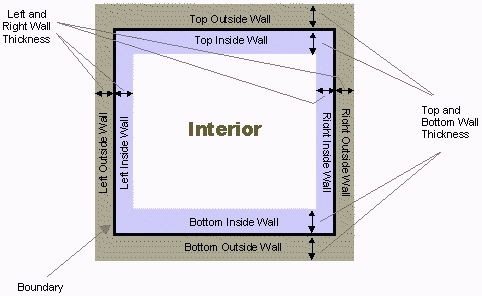An Enclosure allows you to define a rectangular boundary. The edges on the boundary may behave like hard walls and be resistive to your push, or they may be magnetic and pull your hand and device's cursor into the enclosure. It's possible to use an Enclosure to attract a user's cursor to a check box item or create an impenetrable rectangular wall in your application. Enclosures may also enclose other effects and give them a rectangular shape.
An Enclosure is defined by a rectangular boundary which separates the Enclosure's inside from its outside. The Enclosure has a set of inside walls lining the inside of the effect boundary, and a set of outside walls lining the outside of the boundary.
All features of enclosures are available on the full force feedback mouse. Some tactile feedback mice can emulate an Enclosure by playing a bump every time the cursor crosses an Enclosure boundary, but the effect will not have the attractive properties and impenetrability of the same effect played on a full force feedback mouse. The Enclosure effect is not supported on joysticks, wheels, or gamepads.
Center
The Center is the location of the top left corner of the rectangular enclosure.
Clipping Mask
Clipping is a visual effect that causes the cursor to jump to the boundary of the Enclosure whenever the cursor is over a wall where Clipping is active. This visual "stickiness" of the Enclosure boundary gives the illusion of wall impenetrability. You can choose which walls of the enclosure will have the clipping effect.
Direction
The direction of an Enclosure is the effect's angle of rotation. You can specify the direction in either Cartesian or polar coordinates. An Enclosure rotates about its top left corner. The angle of rotation is the angle swept out from the coordinate system's Y-axis by the upward-extended left edge of the Enclosure rectangle.
To determine the direction in Cartesian coordinates, place the bottom left corner of the rectangle at the origin of the graph. Pick any point along the left edge of the rectangle and determine its coordinates.
To determine the angle in polar coordinates, place the bottom left corner of the rectangle at the origin of the graph. Determine the angle from the y-axis to the left edge of the rectangle.
Gain
Gain is a factor with which you can scale the strength of the enclosure.
Inside Effect
An inside effect is an effect that plays only when the cursor is inside the walls of the enclosure.
Rectangle
This property allows you to specify the bounding rectangle for the effect, i.e. the rectangle upon which the Enclosure boundary lies. The top left corner of the Rectangle is a location in absolute screen coordinates, in pixels, and the Rectangle width and height are also in pixels.
Saturation
Saturation indicates the maximum force a wall can exert when resisting penetration.
Stiffness
Stiffness determines how strong the walls are. The stiffer the wall is, the faster the resisting force reaches the saturation level. A negative Stiffness value causes the user to be pulled into the Enclosure boundary. A positive Stiffness value resists the user's movement in toward the boundary.
Stiffness Mask
The Stiffness Mask determines which of the Enclosure's walls apply resistive forces. In combination with the sign of the Stiffness property (positive or negative) and the walls specified in the Clipping Mask, the Stiffness Mask is an important determinant of the specific type of sensation imparted by the Enclosure.
Thickness
The Thickness of an Enclosure wall is the distance the wall extends from the boundary into the Enclosure (inside walls) or from the boundary out of the Enclosure (outside walls). A greater wall thickness provides a greater distance over which the Enclosure boundary can resist penetration, giving the illusion of greater impermeability.

<<
Back to your previous page
Immersion Support Index